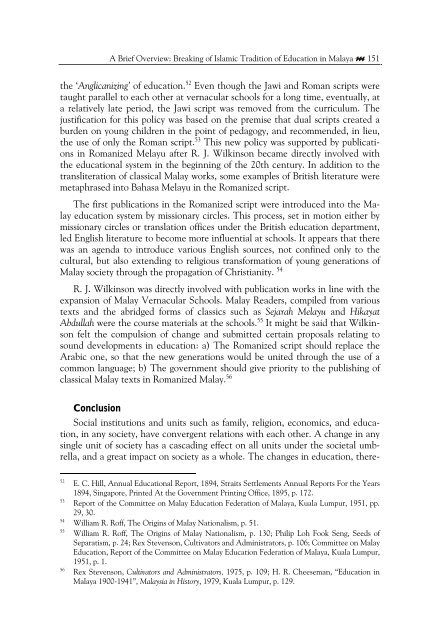İçindekiler - İlahiyat Fakültesi - Marmara Üniversitesi
İçindekiler - İlahiyat Fakültesi - Marmara Üniversitesi
İçindekiler - İlahiyat Fakültesi - Marmara Üniversitesi
Create successful ePaper yourself
Turn your PDF publications into a flip-book with our unique Google optimized e-Paper software.
A Brief Overview: Breaking of Islamic Tradition of Education in Malaya 151<br />
the ‘Anglicanizing’ of education. 52 Even though the Jawi and Roman scripts were<br />
taught parallel to each other at vernacular schools for a long time, eventually, at<br />
a relatively late period, the Jawi script was removed from the curriculum. The<br />
justification for this policy was based on the premise that dual scripts created a<br />
burden on young children in the point of pedagogy, and recommended, in lieu,<br />
the use of only the Roman script. 53 This new policy was supported by publications<br />
in Romanized Melayu after R. J. Wilkinson became directly involved with<br />
the educational system in the beginning of the 20th century. In addition to the<br />
transliteration of classical Malay works, some examples of British literature were<br />
metaphrased into Bahasa Melayu in the Romanized script.<br />
The first publications in the Romanized script were introduced into the Malay<br />
education system by missionary circles. This process, set in motion either by<br />
missionary circles or translation offices under the British education department,<br />
led English literature to become more influential at schools. It appears that there<br />
was an agenda to introduce various English sources, not confined only to the<br />
cultural, but also extending to religious transformation of young generations of<br />
Malay society through the propagation of Christianity. 54<br />
R. J. Wilkinson was directly involved with publication works in line with the<br />
expansion of Malay Vernacular Schools. Malay Readers, compiled from various<br />
texts and the abridged forms of classics such as Sejarah Melayu and Hikayat<br />
Abdullah were the course materials at the schools. 55 It might be said that Wilkinson<br />
felt the compulsion of change and submitted certain proposals relating to<br />
sound developments in education: a) The Romanized script should replace the<br />
Arabic one, so that the new generations would be united through the use of a<br />
common language; b) The government should give priority to the publishing of<br />
classical Malay texts in Romanized Malay. 56<br />
Conclusion<br />
Social institutions and units such as family, religion, economics, and education,<br />
in any society, have convergent relations with each other. A change in any<br />
single unit of society has a cascading effect on all units under the societal umbrella,<br />
and a great impact on society as a whole. The changes in education, there-<br />
52<br />
E. C. Hill, Annual Educational Report, 1894, Straits Settlements Annual Reports For the Years<br />
1894, Singapore, Printed At the Government Printing Office, 1895, p. 172.<br />
53<br />
Report of the Committee on Malay Education Federation of Malaya, Kuala Lumpur, 1951, pp.<br />
29, 30.<br />
54<br />
William R. Roff, The Origins of Malay Nationalism, p. 51.<br />
55<br />
William R. Roff, The Origins of Malay Nationalism, p. 130; Philip Loh Fook Seng, Seeds of<br />
Separatism, p. 24; Rex Stevenson, Cultivators and Administrators, p. 106; Committee on Malay<br />
Education, Report of the Committee on Malay Education Federation of Malaya, Kuala Lumpur,<br />
1951, p. 1.<br />
56<br />
Rex Stevenson, Cultivators and Administrators, 1975, p. 109; H. R. Cheeseman, “Education in<br />
Malaya 1900-1941”, Malaysia in History, 1979, Kuala Lumpur, p. 129.



